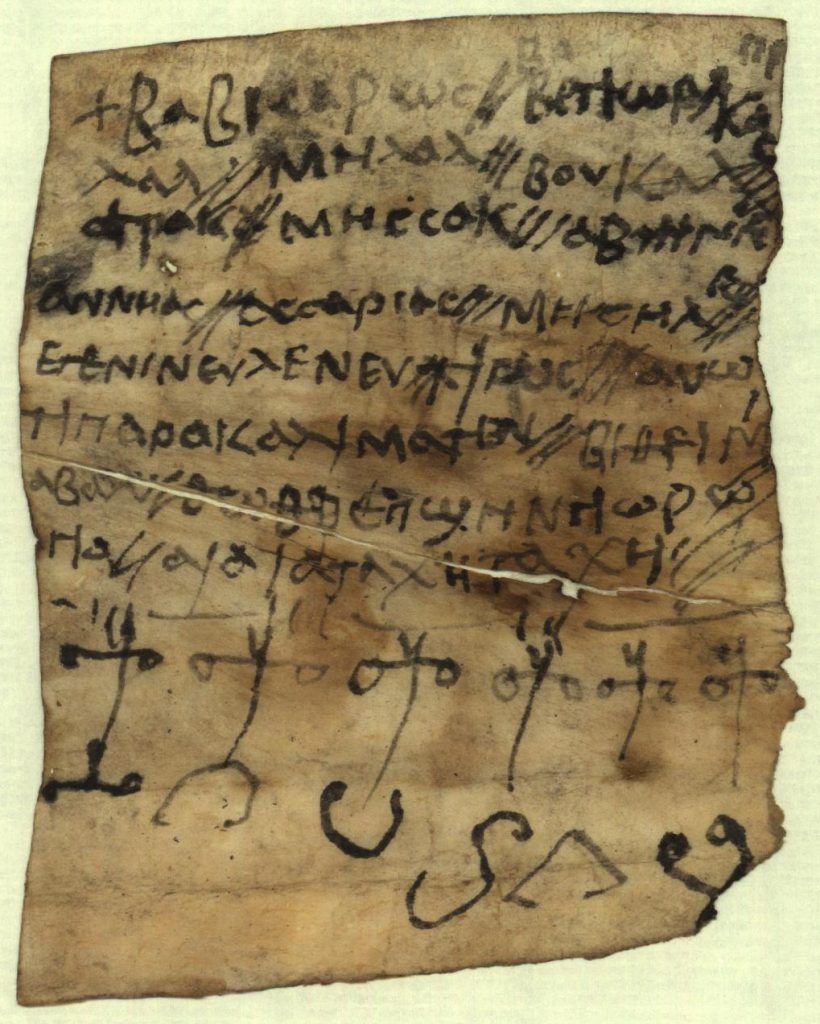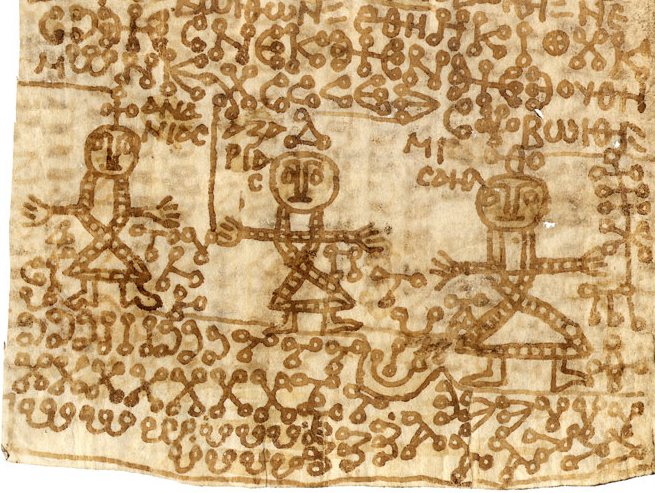This week’s post takes a deep dive into another example of a healing amulet from Kyprianos, our database of Coptic magical texts: Vienna, Nationalbibliothek K 08637 is a sheet of parchment, cut into a rough rectangle measuring 10cm by 8cm. 7 or 8 horizontal creases suggest that this sheet was folded multiple times, or rolled and then squashed. The text’s eight lines of text and two lines of characters (magical signs) were inscribed upon the flesh side of the parchment, the inward-facing side of the skin, while the hair side, which would have faced outwards, was left blank. This parchment was edited by Viktor Stegemann in 1934, but since then has received little attention. The manuscript itself served as an activated amulet for taking fever away from a man named Thōthphe, the son of Giorgia.

© Österreichische Nationalbibliothek, Digitale Services
Babisarōs, Babegiōr, Kaprlal, Mēlal, Boukal, Satrak, Mēssak, Abthēnako, Annēas, Assarias, Mēsēl, whose names these are: I entreat and I adjure you (pl.). Take away the fever (from) Thōthphe, the son of Giōrōgia. Yea! Yea! Quickly! Quickly!
Vienna, Nationalbibliothek K 08637 l. 1-8
Between each of the magical names that open the amulet’s invocations, the scribe of the text has added two or three slashes in order to show where one name ends, and another begins. This would have ensured that these exceptional words would have been pronounced correctly – essential for the efficacy of their power and that of the spell.
Notable among those names are those of the Hebrew youths thrown into a blazing furnace by Nebuchadnezzar, King of Babylon, as told in chapter 3 of the Book of Daniel. They are referred to by the Fayumic Coptic version of their Babylonian names – Shadrach (Satrak), Meshach (Mēssak), and Abednego (Abthēnako) – and their Hebrew names – Hanania (Annēas), Azaria (Assarias), and Mishael (Mēsēl). These figures are often invoked in ritual practices against fever. Analogously to how they overcame and survived the heat of the furnace, the patient of such amulets also hoped to overcome and survive the heat of their fever.

Following the invocation of four lines of magical names, the entreaty and adjuration to those names – addressed in the plural – is made. The command is then to “take away the fever (from) Thōthphe, the son of Giōrōgia”, and to do so as soon as possible. The folding or rolling of the sheet that was described above is highly suggestive that the amulet itself would have been carried, if not bound to and worn, by Thōthphe, in order to aid the expulsion of his fever.
At the conclusion of the invocation and command, a long horizontal line separates the Coptic text from the bottom third of the amulet, separated in three places by three vertical lines. In that bottom third we find six “ring signs”, magical characters with rings at the end of each of the strokes used to write them, in the shape of crosses. Below these are six further magical characters, the first and last of which show the same rings. The power required to heal Thōthphe from fever, then, was imbued not only by the invocations to the Three Hebrew Youths or the commands themselves, but also from the inscribing of these ‘magical’ signs on the amulet.
This is one of dozens of Coptic healing spells, and one of numerous examples against fever, that we are entering and editing in Kyprianos, our database of Coptic magical texts. The majority of these manuscripts are “activated”, and so shed light onto the lived experience of real people centuries ago. As we continue the process of editing and (re)discovering these stories, we will aim to continue to share them with you in this, and other, series of posts in the coming months.
We hope that our readers in the northern hemisphere won’t be needing this spell against a fever, especially over the Christmas period!
Bibliography
Stegemann, Viktor. Die koptischen Zaubertexte der Sammlung Papyrus Erzherzog Rainer in Wien. Sitzungsberichte der Heidelberger Akademie der Wissenschaften. Philosophisch-historische Klasse, 1933-34 n°1. Heidelberg: Carl Winters Universitätsbuchhandlung, 1934, no. XXVII (97), p. 21 and 50-52.

2 Comments
Zuzana Vítková
Very interesting article (and pages as well), thank you! One observation to the transcription : could the second line be read: “Lal, Mélal, Boukal” (i.e. the variants of the Coptic names of the Three Youths, usually spelled Lal, Moulal, Boulal”)? It will be also in accordance with the triple symmetry of the spell. As for the first line, could the third name be read: “Kaspr”? (it is only an idea, I know, that the name of the third magos in Coptic tradition is usually Thadias …)
I am looking forward to your database, it will be very useful tool for the research,
Zuzana Vítková
Korshi
Thanks a lot for your comment, Zuzana, I think you’re perfectly right – Lal, Mēlal, Boukal is a better reading. Kaspr does seem like a better interpretation of the text too, but, as you note, we’d expect Thaddias in Coptic – but maybe this represents the influence of Latin traditions on Egypt?